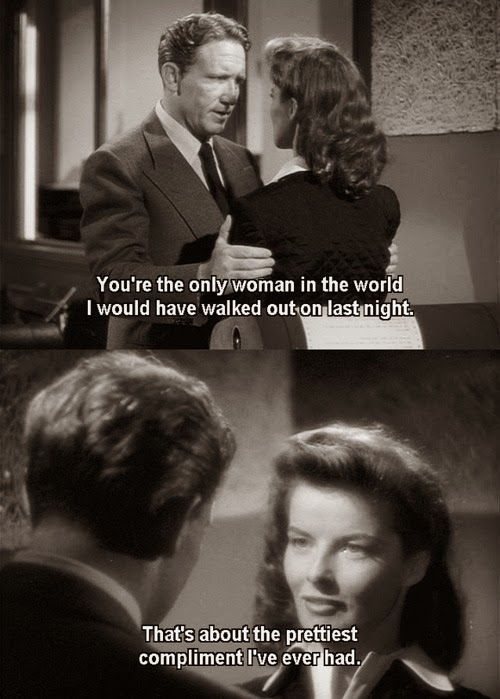 |
| Kate the Great as photographed by Ernest Bachrach. |
*In conjunction with The Great Katharine Hepburn Blogathon of May 10-May 12 2014 as hosted by Margaret Perry.
 |
| Taking to the Skies like the guys in Christopher Strong. |
 |
| Kate in the stage production of "The Warrior's Husband," which exemplifies not only her rebellion against submission but an example of her early twisting of gender roles. |
 |
| Dietrich being devious... with a wink. |
In keeping, at the end of Morocco, Marlene still has to don a skirt and traipse after her man (again Cooper) to prove her worthiness of womanhood, and the more macho Cagney and Cooper, in their respective films, have to in various ways exude more male confidence to negate and thereby make fun of the homosexual, “girly-men” in their films. The message left behind is that such sexually incoherent gender trespassers are inadmissible in reality. Play with these delineations as one may, as far as symbolism is concerned, a man must still “be a man” and a woman a woman in order for the world to turn.
 |
| Perfect fusion of Kate's both masculine and feminine beauty. |
 |
| Still vibrant. |
Kate was equally indefinable as an actress, being neither the Gal Friday nor the femme fatale, and she rarely, rarely played mothers. The maternal instinct was totally lost on her. It wasn’t in accordance with who she was, and her portrayals of a mother on the screen could definitely feel unnatural (State of the Union), if only because such a display was irrefutable proof that she was absolutely a female who had at least once been penetrated/dominated (figuratively and literally) by a male force. (Though my guess is that she was on top). In any case, "Mom" was far too distinctive a title to be placed upon her. To be a mother would immediately erase her chameleon-like abilities as a gender blender and sell her incredibly malleable abilities short. Mostly, it would remove her androgynous Sainthood. Audiences didnt like Kate in a form fitting box. They wanted to see her ram her head against the wall 'til it gave. In truth, her audiences would be less surprised to discover that she had actually knocked up say Colin Clive or Fred MacMurray than they would to find her sitting in a rocking chair with a fat belly, knitting booties for "Junior."
 |
| Alice Adams |
 |
| Holding her own with or without Bogie in The African Queen |
 |
| Sylvia Scarlett |
 |
| With Fredric March in Mary of Scots |
 |
| With Cary in her net in Bringing Up Baby |
 |
| The bride wore shame. |
_02.jpg) |
| "Swingin' Door Sue makes her play in the pen'. |
 |
| Dressed down and chumming between takes. |
 |
| Tracy and Hepburn |
_07.jpg) |
| A date so good, they didn't want to let go... |
 |
| Rebuffed. |
 |
| Spence and Kate, post-slap. |
 |
| At ease. |
 |
| The epitome of the androgynous allure. She is indefinable and everything. |
She was a great guy. And one Hell of a lady.
This is such a great in-depth analysis. Thanks for participating, Meredith!
ReplyDeleteThanks, lady! I was honored. Anything for Kate. :)
DeleteThe article is mesmerizing. I had a great time reading it. Thank you for this thought-through analysis of an "absolutely fascinating" persona.
ReplyDeleteThank you! I'm so glad you enjoyed it. It definitely took a little elbow grease to get it finished in time. She's too complicated to write about in brief, hahaha. I appreciate you visiting. :)
DeleteWhat a thorough and fascinating examination. It made me think of Tilda Swinton. I'd never thought of them together before, but she too has used the power of androgyny in fascinating ways, and I can easily see Hepburn playing Orlando, among many of Swinton's other roles.
ReplyDeleteThat's a great parallel to draw. Tilda definitely incorporates the same aspects and is a talented actress herself. I'd love to see Kate as Orlando! Hahaha. AMAZING!
DeleteA wonderful and in-depth post. I'm happy to have discovered your blog through this blogathon (that's the point, right?!), and I can't wait to read more.
ReplyDeleteThank you so much! I'm glad you got something out of it. I wish I could do such essays regularly, but time rarely permits! But please do check out my glossary and introduce yourself to past articles and tidbits. It's all about fun and movie love. I appreciate you visiting. If you have a blog yourself, I will certainly stop by. :)
Delete